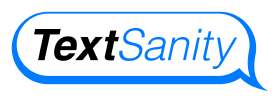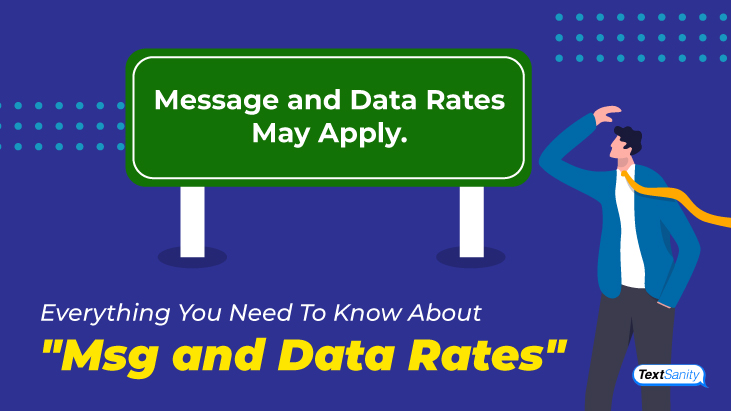Everything You Need to Know About “Msg and Data Rates“
We once had to wait until a specific time in the day or weekend before our text messages were free. Those of us who endured those dystopian times have become accustomed to sending text messages whenever we like.
Although most mobile phone users now have unlimited talk, text, and data, there are cellular plans that still limit these features. Subsequently, message and data rate disclosures should be provided before your customers opt-in to receive texts.
 What does “Msg and Data Rates May Apply” mean?
What does “Msg and Data Rates May Apply” mean?
Data and message rates are fees that customers may be charged by their cellular service provider for receiving or sending text messages from their devices. This is especially important in business texting.

Simply put, SMS marketing and business texting involve automated texting between a business and a customer or prospect. Although the cadence of these messages will be established with deliberate intention by the business, the texts, without proper informing, could seem random to the customer.
In lieu of randomness, the customer has a right to know that receiving these marketing texts could result in them having to pay a fee for each text. Additionally, if the messages contain multimedia content, they may be billed for the data used to open or view it.
You can’t determine which of your customers will incur data or message charges. Therefore, a standardized message indicates they may be and offers your customers transparency.
We urge you to not assume your customers understand that they may be charged for receiving your texts. Doing so could lead to an unpleasant customer experience that could influence that customer to abandon doing business with you.
Do data rates apply with unlimited data?

Generally, if your customer has a phone plan that offers unlimited data, they won’t incur any charges for using data in any amount. However, almost all unlimited data plans come with exclusions and limitations.
For instance, some data plans are unlimited only when connected to the provider’s cell network or not traveling internationally. Some carriers charge a fee for using data on partner networks or when using a network in a foreign country.
Why is this important to you? When you send out a keyword campaign, scheduled mass text message, or drip campaign, it’s sent automatically. Additionally, you have no way of knowing where the customer will be when the message is sent; therefore, you cannot guarantee that they won’t incur charges.
Let’s say one of your customers is traveling on a quick trip to Canada for the weekend, and their cellular provider doesn’t offer unlimited data once they connect to a service provider. If they leave their phone off airplane mode, they will receive any texts or data messages you send. When they get their next bill, they will see charges for those messages.
What are standard data rates?
Data rates can be complicated to understand, but we promise to do our best to simplify them. Data rates are the transmission bandwidth that carries digital signals from the source to the recipient.
Most of us are familiar with these bandwidths when they are defined numerically. For example, if you’ve ever used a network speed testing app like Speedtest, you may have seen your transmission bandwidth rates displayed as 50 Mb per second or, if you are lucky, 300 Mb per second.
Carriers develop data blocks for billing purposes and give customers a defined pricing schedule. Most carriers offer data plans in Gigabyte (Gb) options. If you have a 1 Gb plan, the data you use is included in the price you already pay. When you go over 1 Gb, you may incur another Gb’s worth of data charges.
These defined pricing schedules are the standard data rates being charged by that carrier.
Do text messages use your data?
While standard data rates only apply to data and not SMS messages, certain messaging apps like iMessage and Google Messages use a combination of both SMS and MMS messaging protocols. This means text and data may be used simultaneously.

Other common messenger apps like Facebook Messenger and Textra also use both data and SMS to send and receive messages. Therefore, text messages can use your data, especially if they contain multimedia like videos, graphics, or GIFS.
Additionally, the customer will incur data usage after engaging with that link if you embed a link to your website, social media, webform, or online video hosting site.
As you can see, we tend to think that texting is texting and using data that occurs when we are on a website or using our social media accounts, but with the advancements made in mobile and digital technologies, the two worlds often collide.
 Text marketing best practices
Text marketing best practices
Your reputation is just as important as the quality of your services and products, if not more. A good reputation starts with the first impression and is sustained through a commitment and adherence to professionalism and transparency.
Be clear about possible charges
Your customers won’t do business with companies they believe are disingenuous or disconnected from their concerns and values. Therefore, you must make it a mission and priority to give them disclosures and advisories about potential charges they may experience due to receiving text messages from you.
The average mobile phone user is aware of what type of plan they have and what charges they may experience. However, that does not eliminate your responsibility as a business to be clear about any possible costs your SMS marketing may cause.
Get permission from subscribers

Getting permission from your SMS subscribers beforehand shows that you are being transparent. We hear a lot about transparency in politics and government, and that is because it is important to almost everyone, and this importance is not reserved only for the government.
Consumers want the companies they spend their money with to be transparent. From how they source and manufacture their products to how they treat their employees and handle their personal data.
Getting their permission to receive business texts from you demonstrates your willingness to pull the curtains back and let them shine a light on your business practices. They will appreciate that you asked for permission versus having to ask for forgiveness.
Automate your messaging cadence
TextSanity offers you a variety of tools to automate your SMS marketing campaigns. Drip campaigns are initiated after someone engages with the short code or phone number of one of your automated keyword campaigns. Once they respond to your call to action, they will receive automated messages and notifications in a defined cadence.
The beauty of drip campaigns lies in their ability to keep your customers actively participating and engaging with your company’s touch points. From your social media accounts to your website, drip campaigns allow you to stay at the forefront of your customer’s minds.
Automating this cadence gives you and your team the space required to research and develop marketing strategies with high conversion rates and all but eliminates the inevitable human errors that can come without automation.

What to do next
If SMS marketing sounds like a good fit for your company, you’re at the right place. SMS text messages have an open rate of over 98%, substantially higher than the open rate of email marketing.
TextSanity helps you capitalize on the power SMS texting has to offer. Our online platform is purposely designed to make creating, editing, sending, and automating your business text messages, keyword and drip campaigns, and customer data collection and categorization easy and straightforward.
Call, text, or chat with us online to discover how we can help propel your marketing to the next level!


